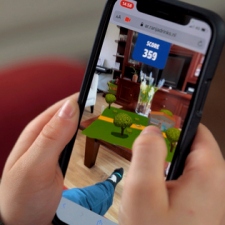While AR is certainly a technology and gaming niche with its fans, its uptake hasn't always been as dramatic as some have predicted. Genre pioneers Niantic know that for every Pokémon Go or Monster Hunter Now they've a Marvel: World of Heroes or NBA All-World.
However, in the pursuit of popularisting (and dominating) augmented reality gaming the creation of their 8th Wall platform has certainly put them ahead of the competition. Now the company is aiming to revolutionise the uptake of augmented reality AR through WebAR technology, eliminating the need for app downloads.
To make AR accessible to all, 8th Wall enables brands to build real-time interactive AR experiences directly in browsers.
As a result, according to Statista, the number of mobile AR users is projected to reach 1.7 billion by 2024, making 8th Wall's mobile-centric approach a commendable win. The web development platform is committed to equipping brands, developers, and creative agencies with tools to craft immersive AR experiences without barriers and is now looking to enhance its offerings with its WebAR tech.
In its attempt to bridge the development gap between iOS and Android, 8th Wall ensures compatibility with nearly five billion smartphones worldwide with around 100,000 web apps and 2,800 commercial experiences, with the report listing some of the browser-first innovations that 8th Wall brings to enhance the WebAR experience:
Mobile-first enhancements
Metaversal Deployment Enhancements: Extending mobile WebAR experiences to mixed reality headsets, allowing developers to create once and deploy everywhere.
Sky Effects + World Tracking: Augmenting the sky and ground simultaneously for a more immersive WebAR experience.
Shared AR Tools: Introducing synchronous and asynchronous multiplayer experiences, enhancing social engagement in WebAR.
Lightship VPS for Web: Transforming real-world locations into interactive destinations, providing centimetre-level accuracy for precise AR interactions.
Lightship Maps for Web: Enabling developers to easily integrate customisable maps into their projects.
Image Targets: Bringing flat, cylindrical, and conical objects to life through AR experiences activated by and tracked directly to the target.
Face Effects: Allowing users to render a face mesh instantly with customisable visual effects, enhancing facial AR interactions.
Hand Tracking: Providing tools for applications that use hands, wrists, and fingers simultaneously, expanding the canvas for AR interactions.
Bringing AR to mobile devices
The recent launch of Niantic’s Wol, a mixed reality experience powered by 8th Wall, showcases the platform's versatility. Metaversal Deployment features allow developers to build once and deploy everywhere, from mobile devices to VR headsets, illustrating the platform's readiness for mixed reality devices such as Apple's Vision Pro and Meta Quest Pro.
In a mobile-centric world where AR adoption is on the rise, 8th Wall is seemingly on the right track by working towards simplifying WebAR development and enhancing AR experiences on mobile. As the AR landscape continues to evolve, 8th Wall's focus on mobile experiences aims to position Niantic as a key player in shaping the future of augmented reality.





















